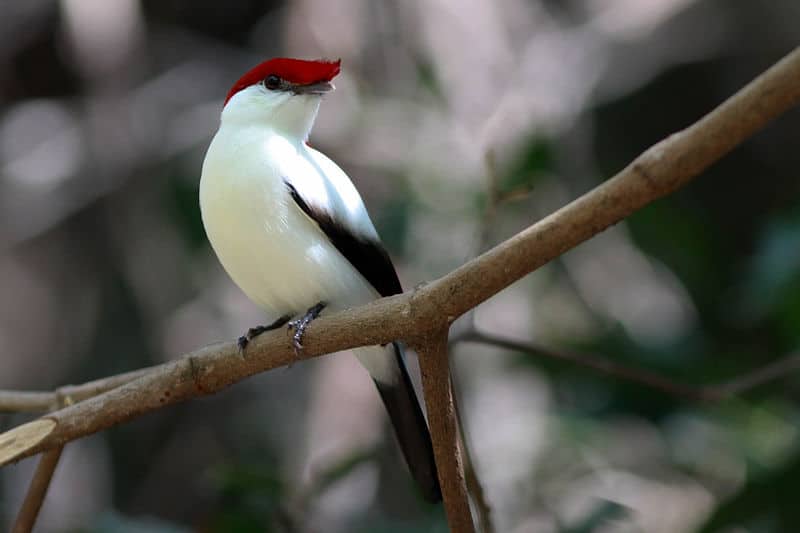Araripe Manakin Facts
- The distinctive term of Araripe Manakin serves as the generally accepted english language common name for a remarkable variety of avian. The animal does have another term it’s known by, though. That’s the title of Chapada do Araripe Manakin.
- Within the scientific community, however, it’s perhaps better known by its technical designation. Regrattably, though, like many such tags, that’s somewhat hard for the layperson to pronounce. That’s because it holds the epithet Antilophia bokermanni.
- By either name, though, this admittedly lovely animal stands out from the crowd for a most regrettable reason. In point of fact, this marvelous creature currently ranks as one of the rarest of all known birds in existence, anywhere on the entire planet.
- Quite amazingly, its discovery did not occur until the year 1996, and that happened entirely accidentally. It received its scientific name in honor of the highly renowned late Brazilian zoologist, Werner Bokermann, who passed away in 1995.
- Presently, official estimates place its known number of surviving members at fewer than 800 individuals. The IUCN, therefore, quite understandably now lists it as Critically Endangered. This status appears on the organization’s Red List.
- Given its natural habitat range, the peril of habitat loss poses one of the leading threats to the Araripe Manakin at the moment. The ongoing effects of climate change, however, also threaten it with possible extinction, just as it does many other species.
Related Articles
Araripe Manakin Physical Description
Although the magnificent Araripe Manakin truly does impress those fortunate enough to encounter it, the animal does not do so due to size. That’s due to the fact that, in this way , in fact, the marvel of Nature only ranks as an average sized member of its Class.
Like many of its kind, the beautiful bird also displays a significant degree of the physiological characteristic of sexual dimorphism. In its particular case, though, this principle manifests itself in terms of a difference in the plumage between the two different genders.
Mature individuals of both sexes nonetheless achieve roughly the same physical dimensions. An average overall length of the body equals roughly 6 in (15 cm). The tail of the lovely creature also tends to develop as somewhat lengthy in relation to the body size.
Both males and females of this remarkable product of evolution display relatively short, stout bills. In coloring, these features tends to be dark. The legs and feet additionally typically present darker shades, varying from hues of black to brown between specimens.
The males of the colorful Araripe Manakin generally have vibrant plumage with a predominantly bright reddish-orange head, neck, and upper breast. The back and wings show black, contrasting with the colors of the head. The lower breast and belly are white.
The genders distinguish themselves in yet another manner, as well, though. The males also possess an elaborate display crown that females conspicuously lack. This develops with two elongated central feathers that can be raised during its courtship displays.
Females, meanwhile, present a very different color scheme to the world. This gender, indeed, has a more subdued appearance, with olive-green upperparts and a pale grayish-white underbelly. They’re also typically slightly smaller in size than their male counterparts.
- Kingdom: Animalia
- Phylum: Chordata
- Class: Aves
- Order: Passeriformes
- Family: Pipridae
- Genus: Antilophia
- Species: A. bokermanni
Araripe Manakin Distribution, Habitat, and Ecology
Most unfortunately, the marvelous Araripe Manakin appears to have evolved as native to only a tiny portion of the world. More specifically, this highly limited zone of natural habitation consists solely of a small part of the country of Brazil, in South America.
Even there, though, this natural wonder just makes its home in the region consisting of the Chapada do Araripe section. This lies approximately in the northeastern section of the country. The entirety of that area totals just a part measuring about 19.3 sq mi (50 sq km).
This particular region also has some unique properties, including the presence of a remarkable limestone-based soil type. For now, scientists have no idea whether or not this represents an important environmental need for the animal. It’s certainly possible, though.
The beautiful work of Nature also inhabits the second-growth sections of the locally abundant forest. These primarily consist of regions of semi-deciduous forest, specifically the humid forest remnants and gallery forests. It prefers to inhabit the understory and edges.
The Araripe Manakin evolved as mainly insectivorous, but also consumes small fruits and seeds. It forages in the understory and edges of the forest, searching for insects and other invertebrates among the vegetation. Its diet may vary seasonally based on food availability.
Breeding typically occurs during the rainy season, which, in northeastern Brazil generally spans from January to July. Males perform courtship displays to attract females. After mating, females build cup-shaped nests in the understory, where they lay and incubate eggs.
Quite thankfully, conservation efforts are now underway, with its remaining habitat being declared a protected area. Several areas sharing similar environments also now hold a protected status, with these being considered as possible sites for breeding programs.
Species Sharing Its Range
Check out our other articles on 6 Mysterious Natural Phenomena, Flamingo Tongue Snail, Great Salt Lake, Lotus Corniculatus, Cougar, Rough-nosed Horned-Lizard, Fire Salamander, Silky Afgekia

